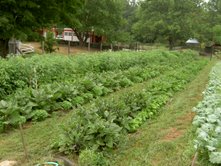Agroecosystem
Agroecosystem refers to a community of plants and animals interacting with their physical and chemical environments that have been modified by people to produce food, fiber, and other products for human consumption and processing. The term is a subset of the broader concept of ecosystems, but with a specific focus on agricultural activities and their impact on the environment. Agroecosystems can range from small-scale, mixed-cropping systems to large-scale industrial farms.
Characteristics[edit | edit source]
Agroecosystems are characterized by their managed nature. Humans play a critical role in their formation and maintenance, determining factors such as species composition, spatial distribution, and the cycling of nutrients and energy. Key characteristics include:
- Simplified biodiversity: Compared to natural ecosystems, agroecosystems often have reduced biodiversity because they are usually dominated by a few species of crops or livestock.
- Cyclic and linear energy flows: Energy in agroecosystems flows in more controlled cycles, often with inputs from outside the system, such as fertilizers and pesticides.
- Altered nutrient cycles: Human management often disrupts natural nutrient cycles, leading to the need for artificial nutrient inputs or the creation of waste products.
- Soil management: Soil health and structure are actively managed through practices like tillage, crop rotation, and the addition of organic or inorganic amendments.
Components[edit | edit source]
An agroecosystem encompasses various components, including:
- Soil: The foundation of any agroecosystem, providing nutrients, water, and support for plants.
- Crops and livestock: The primary biological components, selected for their productivity and suitability for human use.
- Pests and diseases: Organisms that can negatively impact agricultural productivity, requiring management.
- Farmers and agricultural workers: Humans are integral to the operation and management of agroecosystems.
- Agricultural machinery and infrastructure: Tools and structures that support farming activities.
Sustainability[edit | edit source]
Sustainability in agroecosystems involves managing these systems in ways that maintain their productivity and usefulness to society while minimizing negative environmental impacts. This can include practices like:
- Integrated Pest Management (IPM): A holistic approach to pest control that combines biological, cultural, physical, and chemical tools in a way that minimizes economic, health, and environmental risks.
- Conservation agriculture: Practices that aim to conserve, improve, and make more efficient use of natural resources through integrated management of soil, water, and biological resources.
- Agroforestry: The integration of trees and shrubs into agricultural landscapes to enhance biodiversity, improve soil health, and increase overall productivity.
Challenges and Opportunities[edit | edit source]
Agroecosystems face numerous challenges, including climate change, soil degradation, water scarcity, and the need to feed a growing global population. However, they also offer opportunities for innovation in sustainable agriculture, such as the development of more efficient farming techniques, the adoption of renewable energy sources, and the enhancement of ecosystem services.
Conclusion[edit | edit source]
Agroecosystems are complex systems that are essential to human survival. Their sustainable management is crucial for ensuring food security, protecting the environment, and supporting rural livelihoods. By understanding the dynamics of agroecosystems, we can develop more resilient and productive agricultural practices that benefit both people and the planet.
| Agroecosystem Resources | ||
|---|---|---|
|
| |
Translate to: East Asian
中文,
日本,
한국어,
South Asian
हिन्दी,
Urdu,
বাংলা,
తెలుగు,
தமிழ்,
ಕನ್ನಡ,
Southeast Asian
Indonesian,
Vietnamese,
Thai,
မြန်မာဘာသာ,
European
español,
Deutsch,
français,
русский,
português do Brasil,
Italian,
polski
Navigation: Wellness - Encyclopedia - Health topics - Disease Index - Drugs - World Directory - Gray's Anatomy - Keto diet - Recipes
Search WikiMD
Ad.Tired of being Overweight? Try W8MD's physician weight loss program.
Semaglutide (Ozempic / Wegovy and Tirzepatide (Mounjaro) available.
Advertise on WikiMD
WikiMD is not a substitute for professional medical advice. See full disclaimer.
Credits:Most images are courtesy of Wikimedia commons, and templates Wikipedia, licensed under CC BY SA or similar.
Contributors: Prab R. Tumpati, MD


